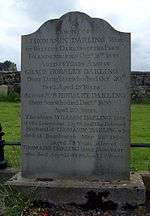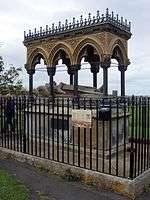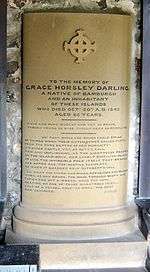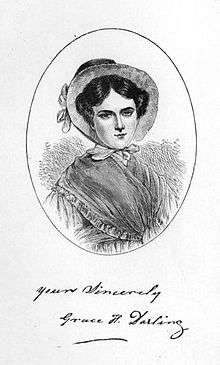Grace Darling

Grace Horsley Darling (24 November 1815 – 20 October 1842) was an English lighthouse keeper's daughter, famed for participating in the rescue of survivors from the shipwrecked Forfarshire in 1838. The paddlesteamer ran aground on the Farne Islands off the coast of Northumberland in northeast England; nine members of her crew were saved.
Biography
Grace Darling was born on 24 November 1815 at her grandfather's cottage in Bamburgh in Northumberland. She was the seventh of nine children (four brothers and four sisters) born to William and Thomasin Darling, and when only a few weeks old she was taken to live on Brownsman Island, one of the Farne Islands, in a small cottage attached to the lighthouse.
Her father ran the lighthouse (built in 1795) for Trinity House and earned a salary of £70 per annum with a bonus of £10 for satisfactory service. The accommodation was basic and the lighthouse was not in the best position to guide shipping to safety, so in 1826 the family moved to the newly constructed lighthouse on Longstone Island.
Longstone Lighthouse had better accommodation, but the island itself was slightly less hospitable, so William would row back to Brownsman to gather vegetables from their former garden and to feed the animals. The family spent most of their time on the ground floor of the lighthouse which consisted of a large room, heated by a wood stove. The room was their living room, dining room and kitchen in one and had a spiral staircase leading to three bedrooms above and the light at the top of the tower.[1]
In the early hours of 7 September 1838, Darling, looking from an upstairs window, spotted the wreck and survivors of the Forfarshire on Big Harcar, a nearby low rocky island. The Forfarshire had foundered on the rocks and broken in half: one of the halves had sunk during the night.

She and her father William determined that the weather was too rough for the lifeboat to put out from Seahouses (then North Sunderland), so they took a rowing boat (a 21 ft, 4-man Northumberland coble) across to the survivors, taking a long route that kept to the lee side of the islands, a distance of nearly a mile. Darling kept the coble steady in the water while her father helped four men and the lone surviving woman, Mrs. Dawson, into the boat. Although she survived the sinking, Mrs Dawson had lost her two young children during the night. William and three of the rescued men then rowed the boat back to the lighthouse. Darling then remained at the lighthouse while William and three of the rescued crew members rowed back and recovered four more survivors.
Meanwhile, the lifeboat had set out from Seahouses but arrived at Big Harcar rock after Darling and her father had completed their rescue operation: all they found were the dead bodies of Mrs Dawson's children and of a vicar. It was too dangerous to return to North Sunderland so they rowed to the lighthouse to take shelter. Darling's brother, William Brooks Darling, was one of the seven fishermen in the lifeboat. The weather deteriorated to the extent that everyone was obliged to remain at the lighthouse for three days before returning to shore.
The Forfarshire had been carrying 62 people. The vessel broke in two almost immediately upon hitting the rocks. Those rescued by Darling and her father were from the bow section of the vessel which had been held by the rocks for some time before sinking. All that remained at daybreak was the portside paddlebox casing. Nine other passengers and crew had managed to float off a lifeboat from the stern section before it too sank, and were picked up in the night by a passing Montrose sloop and brought into South Shields that same night.[2]
As news of her role in the rescue reached the public, her combination of bravery and simple virtue set her out as exemplary, and led to an uneasy role as the nation's heroine. Grace and her father were awarded the Silver Medal for bravery by the Royal National Institution for the Preservation of Life from Shipwreck, later named the Royal National Lifeboat Institution.[3] Subscriptions and donations totaling over £700 were raised for her, including £50 from Queen Victoria; more than a dozen portrait painters sailed to her island home to capture her likeness, and hundreds of gifts, letters, and even marriage proposals were delivered to her.
Her unexpected wealth and fame were such that the Duke of Northumberland took on a role as her self-appointed guardian and founder of a trust, established to look after the donations offered to her. His personal gifts to her and her family included a timepiece, and a silver teapot.
In 1842, Grace fell ill while visiting the mainland, and was in convalescence with her cousins, the MacFarlanes, in their house in Narrowgate, Alnwick. The Duchess of Northumberland heard of her situation, and arranged for her to be moved to better accommodation close to Alnwick Castle, and tended to the ailing heroine in person as well as providing Grace with the services of the ducal family physician.
Grace's condition declined, however, and in the final stages of her illness she was conveyed to the place of her birth, in Bamburgh. Grace Darling died of tuberculosis in October 1842, aged 26.
Legacy

Darling is buried with her father and mother in a modest grave in St. Aidan’s churchyard, Bamburgh, where a nearby elaborate cenotaph commemorates her life. A plain stone monument to her was erected in St. Cuthbert’s Chapel on Great Farne Island in 1848.


Darling’s achievement was celebrated in her lifetime: she received a large financial reward in addition to the plaudits of the nation. A number of fictionalised depictions propagated the Grace Darling legend, such as Grace Darling, or the Maid of the Isles by Jerrold Vernon (1839), which gave birth to the legend of “the girl with windswept hair”. Her deed was committed to verse by William Wordsworth in his poem Grace Darling (1843). A lifeboat with her name was presented to Holy Island. One of a series of Victorian paintings by William Bell Scott at Wallington Hall in Northumberland depicts her rescue. The McManus Galleries in Dundee includes three paintings by Thomas Musgrave Joy which celebrate Grace Darling's deeds with the Forfarshire.[4]
At Bamburgh, there is a museum dedicated to her achievements and the seafaring life of the region. It re-opened in December 2007 following renovation. The Royal National Lifeboat Institution Mersey class lifeboat at Seahouses bears the name Grace Darling.
Singer/songwriter Dave Cousins of Strawbs wrote "Grace Darling" (on Ghosts) in tribute and as a love song. North East musical playwright Dennis A Westgate wrote a musical based on the life of Grace Darling, exploring her life from childhood through to her death in 1842. The premiere was performed by a community theatre company based in York, The York Stars, July 2010 to help promote Grace Darling and the work of the RNLI.
The children's singing group The Limeliters sang a different "Grace Darling" (featuring the refrain "Help, help, came a desperate yelp!") in their 1962 album, recorded live in concert, Through Children's Eyes.[5]
In 1992 indie band The Hit Parade released "Grace Darling"[6] a song that imagines the death of Grace Darling in Bamburgh.
It was suggested by Richard Armstrong in his 1965 biography Grace Darling: Maid and Myth that she may have suffered from a cleft lip. He is the only biographer to put forward this theory, which has been strongly disputed.
See also
- Grace Bussell, a 16-year-old Australian girl who rescued 50 people from the SS Georgette when it foundered off the West Australian coast in 1876. She is regarded as Australia’s national heroine. At the time of the rescue, Bussell was referred to as the "Grace Darling of the West" by journalists.
- Ann Harvey, a Newfoundland 17-year-old who in 1828, with her father, brother and dog, rescued 163 shipwrecked people.
- Roberta Boyd, a New Brunswick girl who was hailed as the "Grace Darling of the St. Croix” after a rescue in 1882.
Further reading

- Algernon Charles Swinburne's poem "Grace Darling"
- Richard Armstrong: Grace Darling: Maid and Myth (1965)
- Hugh Cunningham: Grace Darling – Victorian Heroine Hambledon: Continuum (2008) ISBN 978-1-85285-548-2
- Thomasin Darling: Grace Darling, her True Story: from Unpublished Papers in Possession of her Family (1880)
- Thomasin Darling: The Journal of William Darling, Grace Darling's Father (1887)
- Eva Hope: Grace Darling – Heroine of the Farne Islands Walter Scott Publishing (1875)
- Jessica Mitford: Grace Had an English Heart. The Story of Grace Darling, Heroine and Victorian Superstar (1998) ISBN 0-525-24672-X
- Constance Smedley: Grace Darling and Her Times Hurst and Blackett (1932)
- H. C. G. Matthew, "Darling, Grace Horsley (1815–1842)", Oxford Dictionary of National Biography, Oxford University Press, 2004
- @RNLI: tweets as the voice of Grace Darling narrating her famous rescue in 'real time' on its 175th anniversary (2013)
References
- ↑ http://www.farne.co.uk/grace_horsley_darling.html
- ↑ William Patten. "The Junior Classics – Volume 7, Stories of Courage and Heroism". Retrieved 22 November 2010.
- ↑ Cox, Barry (1998). Lifeboat Gallantry.
- ↑ Suzanne Fagence Cooper, ‘Joy, Thomas Musgrave (1812–1866)’, Oxford Dictionary of National Biography, Oxford University Press, 2004 accessed 5 Oct 2013
- ↑ The Limeliters - Through Children's Eyes - Grace Darling on YouTube
- ↑ https://www.youtube.com/watch?v=_H7u9ANV8ZI
External links
- Grace Darling Museum from the RNLI
- Grace Darling website
- Information on Grace and the area in which she lived, including Seahouses, Bamburgh, Beadnell and the Farne Islands
- Description of the sinking of the Forfarshire and Grace Darling’s part in the rescue, from The Tragedy of the Seas, 1841, from Google Book Search
- “Grace Darling: Victorian heroine” BBC
- Grace Darling genealogy
Coordinates: 55°38.63′N 01°36.58′W / 55.64383°N 1.60967°W